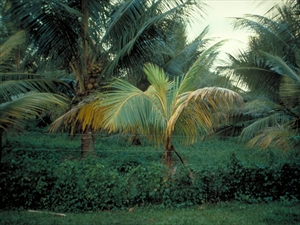- Narrow distribution. In Vanuatu only. On coconut. An important disease only on introduced varieties.
- Leaves in the mid-section of crown turn yellow, break and hang down; the rest remain green. As younger leaves age they too turn yellow, trunks taper and the palm dies. Some varieties recover, e.g., Rennell Tall.
- Spread by a planthopper that lives on wild Hibiscus.
- Biosecurity: follow international guidelines for the transfer of coconuts.
- Cultural control: resistant varieties: Vanuatu tall and Vanuatu dwarf varieties and hybrids between them are resistant.
- Chemical control: none recommended.








